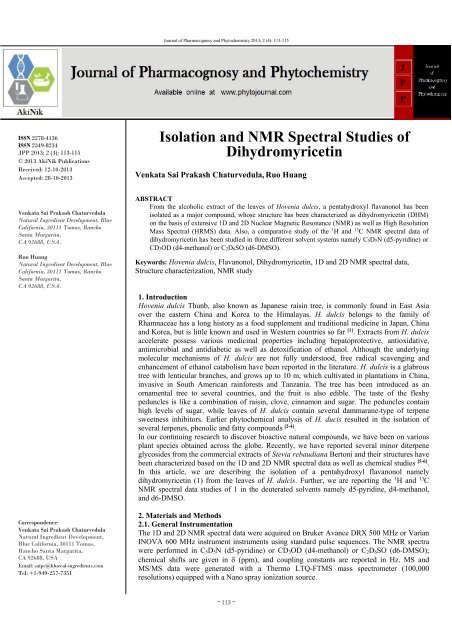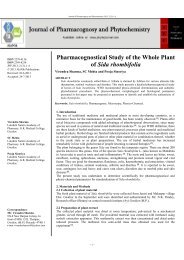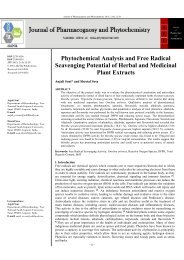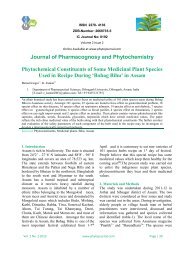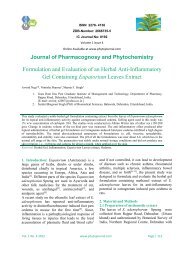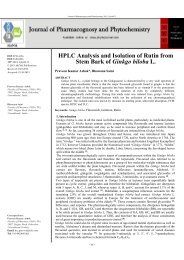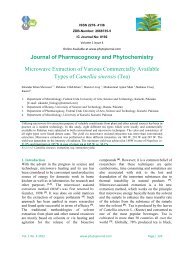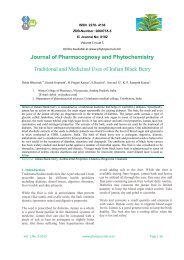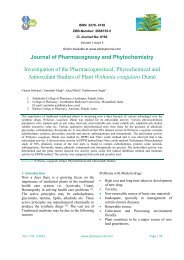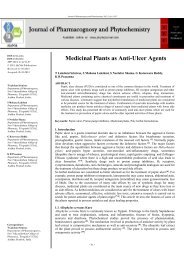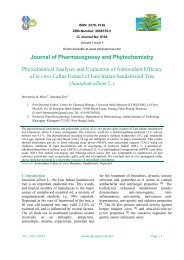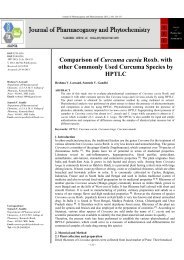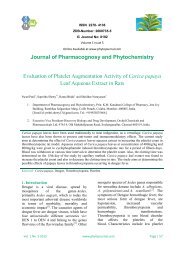Isolation and NMR Spectral Studies of Dihydromyricetin
Isolation and NMR Spectral Studies of Dihydromyricetin - Journal of ...
Isolation and NMR Spectral Studies of Dihydromyricetin - Journal of ...
Create successful ePaper yourself
Turn your PDF publications into a flip-book with our unique Google optimized e-Paper software.
Journal <strong>of</strong> Pharmacognosy <strong>and</strong> Phytochemistry 2013; 2 (4): 113-115<br />
ISSN 2278-4136<br />
ISSN 2349-8234<br />
JPP 2013; 2 (4): 113-115<br />
© 2013 AkiNik Publications<br />
Received: 12-10-2013<br />
Accepted: 28-10-2013<br />
<strong>Isolation</strong> <strong>and</strong> <strong>NMR</strong> <strong>Spectral</strong> <strong>Studies</strong> <strong>of</strong><br />
<strong>Dihydromyricetin</strong><br />
Venkata Sai Prakash Chaturvedula, Ruo Huang<br />
Venkata Sai Prakash Chaturvedula<br />
Natural Ingredient Development, Blue<br />
California, 30111 Tomas, Rancho<br />
Santa Margarita,<br />
CA 92688, USA.<br />
Ruo Huang<br />
Natural Ingredient Development, Blue<br />
California, 30111 Tomas, Rancho<br />
Santa Margarita,<br />
CA 92688, USA.<br />
Correspondence:<br />
Venkata Sai Prakash Chaturvedula<br />
Natural Ingredient Development,<br />
Blue California, 30111 Tomas,<br />
Rancho Santa Margarita,<br />
CA 92688, USA<br />
Email: saipc@bluecal-ingredients.com<br />
Tel: +1-949-257-7351<br />
ABSTRACT<br />
From the alcoholic extract <strong>of</strong> the leaves <strong>of</strong> Hovenia dulcis, a pentahydroxyl flavanonol has been<br />
isolated as a major compound, whose structure has been characterized as dihydromyricetin (DHM)<br />
on the basis <strong>of</strong> extensive 1D <strong>and</strong> 2D Nuclear Magnetic Resonance (<strong>NMR</strong>) as well as High Resolution<br />
Mass <strong>Spectral</strong> (HRMS) data. Also, a comparative study <strong>of</strong> the 1 H <strong>and</strong> 13 C <strong>NMR</strong> spectral data <strong>of</strong><br />
dihydromyricetin has been studied in three different solvent systems namely C5D5N (d5-pyridine) or<br />
CD3OD (d4-methanol) or C2D6SO (d6-DMSO).<br />
Keywords: Hovenia dulcis, Flavanonol, <strong>Dihydromyricetin</strong>, 1D <strong>and</strong> 2D <strong>NMR</strong> spectral data,<br />
Structure characterization, <strong>NMR</strong> study<br />
1. Introduction<br />
Hovenia dulcis Thunb, also known as Japanese raisin tree, is commonly found in East Asia<br />
over the eastern China <strong>and</strong> Korea to the Himalayas. H. dulcis belongs to the family <strong>of</strong><br />
Rhamnaceae has a long history as a food supplement <strong>and</strong> traditional medicine in Japan, China<br />
<strong>and</strong> Korea, but is little known <strong>and</strong> used in Western countries so far [1] . Extracts from H. dulcis<br />
accelerate possess various medicinal properties including hepatoprotective, antioxidative,<br />
antimicrobial <strong>and</strong> antidiabetic as well as detoxification <strong>of</strong> ethanol. Although the underlying<br />
molecular mechanisms <strong>of</strong> H. dulcis are not fully understood, free radical scavenging <strong>and</strong><br />
enhancement <strong>of</strong> ethanol catabolism have been reported in the literature. H. dulcis is a glabrous<br />
tree with lenticular branches, <strong>and</strong> grows up to 10 m, which cultivated in plantations in China,<br />
invasive in South American rainforests <strong>and</strong> Tanzania. The tree has been introduced as an<br />
ornamental tree to several countries, <strong>and</strong> the fruit is also edible. The taste <strong>of</strong> the fleshy<br />
peduncles is like a combination <strong>of</strong> raisin, clove, cinnamon <strong>and</strong> sugar. The peduncles contain<br />
high levels <strong>of</strong> sugar, while leaves <strong>of</strong> H. dulcis contain several dammarane-type <strong>of</strong> terpene<br />
sweetness inhibitors. Earlier phytochemical analysis <strong>of</strong> H. ducis resulted in the isolation <strong>of</strong><br />
several terpenes, phenolic <strong>and</strong> fatty compounds [2-4] .<br />
In our continuing research to discover bioactive natural compounds, we have been on various<br />
plant species obtained across the globe. Recently, we have reported several minor diterpene<br />
glycosides from the commercial extracts <strong>of</strong> Stevia rebaudiana Bertoni <strong>and</strong> their structures have<br />
been characterized based on the 1D <strong>and</strong> 2D <strong>NMR</strong> spectral data as well as chemical studies [5-6] .<br />
In this article, we are describing the isolation <strong>of</strong> a pentahydroxyl flavanonol namely<br />
dihydromyricetin (1) from the leaves <strong>of</strong> H. dulcis. Further, we are reporting the 1 H <strong>and</strong> 13 C<br />
<strong>NMR</strong> spectral data studies <strong>of</strong> 1 in the deuterated solvents namely d5-pyridine, d4-methanol,<br />
<strong>and</strong> d6-DMSO.<br />
2. Materials <strong>and</strong> Methods<br />
2.1. General Instrumentation<br />
The 1D <strong>and</strong> 2D <strong>NMR</strong> spectral data were acquired on Bruker Avance DRX 500 MHz or Varian<br />
INOVA 600 MHz instrument instruments using st<strong>and</strong>ard pulse sequences. The <strong>NMR</strong> spectra<br />
were performed in C 5 D 5 N (d5-pyridine) or CD 3 OD (d4-methanol) or C 2 D 6 SO (d6-DMSO);<br />
chemical shifts are given in (ppm), <strong>and</strong> coupling constants are reported in Hz. MS <strong>and</strong><br />
MS/MS data were generated with a Thermo LTQ-FTMS mass spectrometer (100,000<br />
resolutions) equipped with a Nano spray ionization source.<br />
~ 113 ~
Journal <strong>of</strong> Pharmacognosy <strong>and</strong> Phytochemistry<br />
Samples were diluted with methanol <strong>and</strong> introduced via infusion<br />
using the onboard syringe pump.<br />
2.2. <strong>Isolation</strong> <strong>and</strong> purification <strong>of</strong> dihydromyricetin (1)<br />
The leaves <strong>of</strong> H. dulcis were extracted with ethanol <strong>and</strong><br />
concentrated under vacuum at low temperature. The residue<br />
obtained has been centrifuged <strong>and</strong> then finally crystallized to yield<br />
a pure compound which has been identified as dihydromyricetin<br />
(1).<br />
2.3. Identification <strong>and</strong> spectroscopic data <strong>of</strong> dihydromyricetin<br />
(5, 7, 3′, 4′, 5′-pentahydroxyl flavanonol, 1)<br />
Off-White powder; 1<br />
H-<strong>NMR</strong> (600 MHz, d5-pyridine/d4-<br />
methanol/d6-DMSO, δ ppm) <strong>and</strong> 13 C-<strong>NMR</strong> (150 MHz, d5-<br />
pyridine/d4-methanol/d6-DMSO, δ ppm) spectroscopic data see<br />
Table 1; HRMS (M+Na) + m/z 343.0426 (calcd. for C 15 H 12 O 8 Na:<br />
343.0424).<br />
skeleton in the molecular structure <strong>of</strong> 1. The presence <strong>of</strong> 2, 3-<br />
dihydr<strong>of</strong>lavonol was further supported by the 13 C <strong>NMR</strong> spectral<br />
data which showed the presence <strong>of</strong> oxymethine groups resonating<br />
between δ 71.7 <strong>and</strong> 85.8. In addition, the 1 H <strong>NMR</strong> spectra data <strong>of</strong> 1<br />
also showed the presence <strong>of</strong> two meta-coupled aromatic protons as<br />
doublets between δ 5.86 <strong>and</strong> 6.50, <strong>and</strong> an additional two metacoupled<br />
aromatic protons δ 6.40 <strong>and</strong> 7.24 as singlets corresponds to<br />
a pentahydroxyl flavanonol scaffold. The 1 H <strong>and</strong> 13 C <strong>NMR</strong> values<br />
for all the protons <strong>and</strong> carbons for the compound 1 were assigned<br />
on the basis <strong>of</strong> COSY, HMQC <strong>and</strong> HMBC correlations <strong>and</strong> are<br />
given in Table 1. The key HMBC correlations confirmed the<br />
placement <strong>of</strong> all the five hydroxyl groups at 5, 7, 3′, 4′, 5′ positions<br />
as shown in Figure 1. On the basis <strong>of</strong> above 1D <strong>and</strong> 2D <strong>NMR</strong><br />
spectroscopic data, the structure <strong>of</strong> 1 was determined<br />
unambiguously as dihydromyricetin (5, 7, 3′, 4′, 5′-pentahydroxyl<br />
flavanonol) [10] .<br />
3. Results <strong>and</strong> Discussion<br />
Compound 1 was isolated as an <strong>of</strong>f-white powder, <strong>and</strong> its<br />
molecular formula has been was deduced as C 15 H 12 O 8 from the<br />
adduct ion corresponding to [M+Na] + ion observed at m/z<br />
343.0426; this composition was further supported by the 13 C <strong>NMR</strong><br />
spectral data. . The UV spectrum <strong>of</strong> 1 showed λ max at 261, 319,<br />
<strong>and</strong> 348 nm suggested a flavonoid structure 7-9 . The 1 H <strong>NMR</strong><br />
spectra data <strong>of</strong> 1 has been acquired in all three solvents namely d5-<br />
pyridine, d4-methanol <strong>and</strong> d6-DMSO. The 1 H <strong>NMR</strong> spectra data <strong>of</strong><br />
1 showed two doublet signals between δ 4.48 <strong>and</strong> 5.47 in d5-<br />
pyridine, <strong>and</strong> d4-methanol, whereas a doublet <strong>and</strong> doublet <strong>of</strong><br />
doublets at δ 4.42 <strong>and</strong> 4.91 in d6-DMSO corresponding to a proton<br />
each suggested the 3-hydroxyflavanone or 2, 3-dihydr<strong>of</strong>lavonol<br />
Table 1. 1 H <strong>and</strong> 13 C <strong>NMR</strong> spectral data (chemical shifts <strong>and</strong> coupling constants) for dihydromyricetin (1) a-c .<br />
Position<br />
<strong>NMR</strong> Data in<br />
d5-pyridine<br />
<strong>NMR</strong> Data in<br />
d4-methanol<br />
<strong>NMR</strong> Data in<br />
d6-DMSO<br />
δ H<br />
δ C<br />
δ H<br />
2 5.47 (1H, d, 11.6) 85.8 4.85 (1H, d, 12.1) 85.4 4.91 (1H, d, 12.6) 83.3<br />
3 5.08 (1H, d, 11.8) 73.9 4.48 (1H, d, 12.4) 73.8 4.42 (1H, dd, 12.8, 6.4) 71.7<br />
4 199.3 198.4 197.7<br />
5 165.6 165.4 163.4<br />
6 6.37 (1H, d, 2.4) 97.9 5.88 (1H, d, 2.1) 97.4 5.86 (1H, d, 2.4) 95.9<br />
7 169.3 168.9 166.8<br />
8 6.50 (1H, d, 2.4) 96.8 5.92 (1H, d, 2.2) 96.4 5.91 (1H, d, 2.1) 95.0<br />
9 164.5 164.5 162.6<br />
10 102.3 101.9 100.5<br />
1′ 129.6 129.2 127.2<br />
2′, 6′ 7.24 (2H, s) 109.0 6.63 (2H, s) 108.2 6.40 (2H, s) 106.9<br />
3′, 5′ 148.7 146.9 145.7<br />
4′ 136.7 135.0 133.5<br />
3-OH 5.76 (1H, 6.2)<br />
a<br />
assignments made on the basis <strong>of</strong> COSY, HMQC <strong>and</strong> HMBC correlations; b Chemical shift values are in δ (ppm); c Coupling constants are in Hz.<br />
δ C<br />
δ H<br />
δ C<br />
4. Conclusion<br />
We are herewith reporting the isolation <strong>of</strong> the main constituent <strong>of</strong><br />
the alcoholic extract <strong>of</strong> the leaves <strong>of</strong> Hovenia dulcis, whose<br />
structure has been characterized as dihydromyricetin (1) on the<br />
basis <strong>of</strong> extensive 1D ( 1 H <strong>and</strong> 13 C) <strong>and</strong> 2D (COSY, HMQC <strong>and</strong><br />
HMBC) <strong>NMR</strong> as well as High Resolution Mass <strong>Spectral</strong> (HRMS)<br />
data. Also, we are herewith reporting for the first time the 1 H <strong>and</strong><br />
13<br />
C <strong>NMR</strong> spectral data <strong>of</strong> dihydromyricetin in three different<br />
solvent systems namely d5-pyridine/d4-methanol/d6-DMSO.<br />
~ 114 ~
Journal <strong>of</strong> Pharmacognosy <strong>and</strong> Phytochemistry<br />
5. Acknowledgements<br />
We wish to thank Dr. Wu Shaoxiong, <strong>and</strong> Dr. Bing Wang <strong>of</strong> Emory<br />
University, Atlanta, USA for obtaining some selected spectral data<br />
<strong>and</strong> other chemistry related help.<br />
6. References:<br />
1. Hyun TK, Eom SH, Yu CY, Roitsch T. Hovenia dulcis - An Asian<br />
traditional herb. Planta Medica 2010; 76:943-949.<br />
2. Cho JY, Moon JH, Eun JB, Chung SJ, Park KH. <strong>Isolation</strong> <strong>and</strong><br />
characterization <strong>of</strong> 3(Z)-dodecenedioic acid as an antibacterial<br />
substance from Hovenia dulcis Thunb. Food Science <strong>and</strong><br />
Biotechnology 2004; 13:46-50.<br />
3. Cho JY, Hyun SH, Moon JH, Park KH. <strong>Isolation</strong> <strong>and</strong> structural<br />
determination <strong>of</strong> a novel flavonol triglycoside <strong>and</strong> seven<br />
compounds from the leaves <strong>of</strong> oriental raisin tree (Hovenia dulcis)<br />
<strong>and</strong> their antioxidative activity. Food Science <strong>and</strong><br />
Biotechnology 2013; 22:115-123.<br />
4. Suttisri R, Lee IS, Kinghorm AD. Plant-derived triterpenoid<br />
sweetness inhibitors. Journal <strong>of</strong> Ethnopharmacology 1995; 47:9–26.<br />
5. Chaturvedula VSP, Chen S, Yu O, Mao G. <strong>NMR</strong> spectral analysis<br />
<strong>and</strong> hydrolysis studies <strong>of</strong> rebaudioside N, a minor steviol glycoside <strong>of</strong><br />
Stevia rebaudiana Bertoni. Food <strong>and</strong> Nutrition Sciences 2013;<br />
4:1004-1008.<br />
6. Chaturvedula VSP, Chen S, Yu O, Mao G. <strong>Isolation</strong>, <strong>NMR</strong> spectral<br />
analysis <strong>and</strong> hydrolysis studies <strong>of</strong> a hepta pyranosyl diterpene<br />
glycoside from Stevia rebaudiana Bertoni. Biomolecules 2013;<br />
3:733-740.<br />
7. Nakano K, Takatani M, Tomimatsu T, Nohara T. Four kaempferol<br />
glycosides from the leaves <strong>of</strong> Cinnamomum sieboldi. Phytochemistry<br />
1983; 22:2831-2833.<br />
8. Chaturvedula VSP, Prakash I. Kaempferol glycosides from Siraitia<br />
grosvenorii, Journal <strong>of</strong> Chemical <strong>and</strong> Pharmaceutical Research 2011;<br />
3:799-804.<br />
9. Chaturvedula VSP, Prakash I. Flavonoids from Astragalus<br />
propinquus, Journal <strong>of</strong> Chemical <strong>and</strong> Pharmaceutical Research 2012;<br />
4:2666-2670.<br />
10. Zhang YS, Zhang QY, Wang B, Li LY, Zhao YY. Chemical<br />
constituents from Ampelopsis grossedentata. Journal <strong>of</strong> Chinese<br />
Pharmaceutical Sciences 2006; 15:211-214.<br />
~ 115 ~


